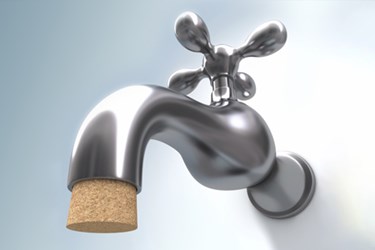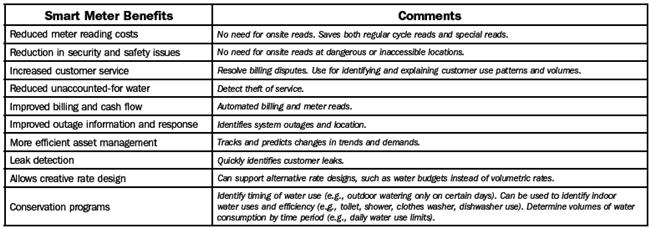7 Ways Smart Meters Save Water

By Dr. Lon W. House, owner, Water and Energy Consulting
In an era of drought and conservation, smart meters can be utilities’ best allies in the fight to preserve water supplies.
Smart meters have been prominent in the energy utility world and are beginning to make substantial inroads in the water utility world. Smart meters are probably more useful for the water sector than for the energy sector, and the old days of billing total water consumption during the last month or two is being phased out with the introduction of time-of-use water consumption information.
Smart meter installations have reported numerous benefits, both operational and on the customer side (see Table 1). Aside from the obvious savings from reduced need for onsite meter reading, the ability to identify not just the volume of water consumption but also the timing of that consumption has significant benefits, particularly to customers, and may be a linchpin for enhanced water conservation efforts. This is particularly an issue for California, where urban water customers are under mandatory 25 percent reductions in water usage due to the lack of available snowpack contributing to the current drought.
Smart Conservation Efforts
Reduced customer leak losses: All smart meter programs provide automatic customer leak detection. According to the algorithm they follow, at some point in a 24-hour period for a duration specified by the water utility, customer’s water consumption should drop to zero. If customer usage never drops to zero, that account is flagged for utility operators’ notice. There are corrective algorithms that account for customer usage of evaporative/swamp coolers if that is a concern in the utility area.
Smart meters collect water consumption data with a timestamp and transfer that information to the utility. This can either be a one-way communication to the utility (AMR — automated meter reading) or a two-way communication between the utility and the individual smart meter (AMI — advanced metering infrastructure).
Outdoor watering day limitations: Another typical water conservation effort is to limit outdoor watering to prespecified days, such as even-numbered days, only on Tuesday or Thursday, etc. Enforcement of this measure without smart meters requires considerable personnel expense, as someone has to physically inspect the site. With smart meter data, customers watering on the wrong days become immediately obvious.
Time-of-use watering restrictions: One water conservation program that is popular is to limit outdoor watering in the daylight or afternoon hours. The enforcement of this type of program has the same issues as the outdoor watering day programs, but interval water consumption data quickly identifies customers who are not participating.
Table 1

Source: Smart Meters and California Water Agencies: Overview and Status, California Energy Commission, CEC-500-2010-008, March 2010.
Creative rate design: Traditional volumetric water rates are being replaced by creative water tariffs in response to policy directives and water conservation efforts. Water budgets have been successfully implemented in California (e.g., by Coachella Valley Water District and Irvine Ranch Water District) as an alternative to volumetric rates. Water budgets specify water consumption volumes based upon individual customer characteristics like lot size, number of bathrooms or bedrooms, and landscaping. Smart meter water data is critical to the success of water budget implementation. It provides customers with detailed information on how much water they are using and when they are using it, and alerts them when they are in danger of exceeding a specific water tier limit and going into a higher-priced bracket.
Identification of customer inefficiencies: Water technologies have identifiable water use patterns. For example, toilets are a quick couple gallons of water usage, whereas dishwashers and clothes washers spread water usage over a much longer timeframe. By knowing the timing and volume of customer water usage, a utility can analyze the various water end uses and, theoretically, identify customer-specific inefficiencies like high-water-use toilets. This application has obvious customer privacy issues but can provide a very useful tool for assisting customers in identifying where they are using water and ways to reduce that water usage.
Verification of water conservation investments: Access to time-varying customer water usage data can provide immediate feedback on the effectiveness of water conservation investments. For example, comparing an hour’s water consumption pre- and post-change of water sprinklers is a graphic illustration of the amount of water saved via the sprinkler conversion.
Timely notification of water conservation efforts: It is very difficult to get timely customer response to conservation programs using traditional monthly or bimonthly water billing. What these traditional bills tell customers is how much water they used more than a month ago. They do not allow a customer to track water usage and adjust water consumption to meet pre-specified conservation efforts, as smart meter data does.
Making The Change
In this new era of water supply limitations, enabling customers to understand how they are using water as well as how much they are using is paramount to program success and customer satisfaction. While smart meter water data can be used in a punitive way, its greatest use is educational; informing customers when they are not participating in the program correctly, notifying them when they are approaching water consumption limits, identifying leaks on their side of the meter, showing them where they are using water, and suggesting behavior options to reduce their water consumption.
While interval water meter data is fundamental to modern water conservation programs, there are issues and concerns about the transition to smart meters. Issues concerning the cost of the new smart meters, their compatibility with existing infrastructure, integration of interval water consumption information into current billing systems, customer access to the water consumption data, and protection of customers’ privacy are legitimate concerns that need to be addressed. But there are creative ways to address them.
An anecdotal illustration of a creative approach to addressing the water interval consumption need can be found in Long Beach, California’s, smart water meter pilot. Rather than changing out the old meters to new smart meters, the city has deployed add-ons to existing water meters. The “Innov8 register” can be added to most common meters to provide data-logging in intervals down to one minute and flow down to 0.2 gallons. The meters then communicate wirelessly over a cellular data network and provide web-based analytics for customers and the utility to see their water usage.
The ready availability of interval water consumption information from smart meters significantly enhances the options for water conservation programs and can greatly improve customer participation and satisfaction in conservation programs. They are a foundational tool for water utilities going into the 21st century.
About The Author
 Dr. Lon W. House is the owner of Water and Energy Consulting, with offices in California and Arizona. House is a consultant to the Association of California Water Agencies and the California Rural Water Association, as well as a water-energy consultant for the California Energy Commission and California Public Utilities Commission. He is also the energy and efficiency trainer for the National Rural Water Association.
Dr. Lon W. House is the owner of Water and Energy Consulting, with offices in California and Arizona. House is a consultant to the Association of California Water Agencies and the California Rural Water Association, as well as a water-energy consultant for the California Energy Commission and California Public Utilities Commission. He is also the energy and efficiency trainer for the National Rural Water Association.
